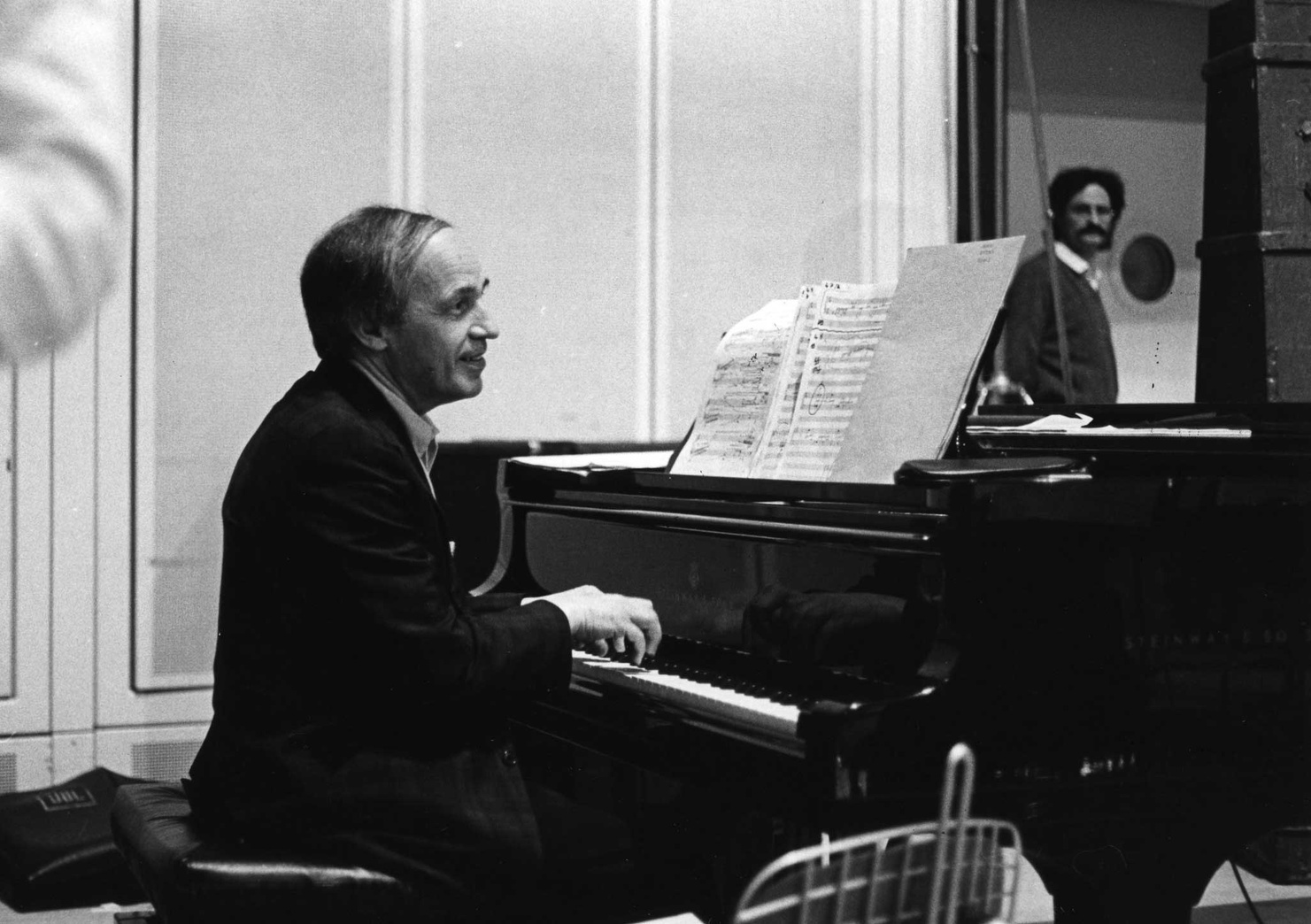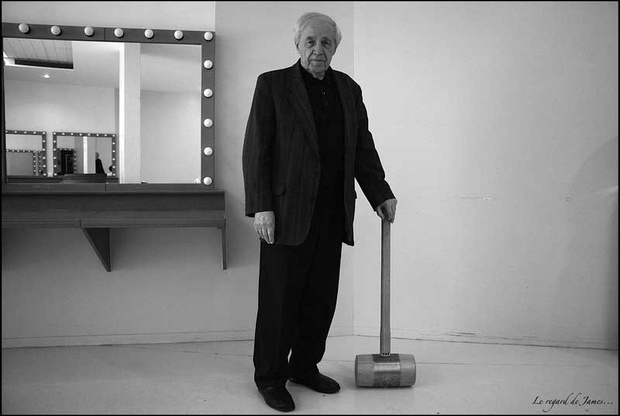Pierre Boulez restera l’homme d’un impératif pratique : « faites, agissez, surtout ne reproduisez pas ». Plus d’une fois entendue, cette injonction a été portée sur plusieurs fronts, contre les états de fait sentencieux, les habitudes solennelles ou obsolètes. Provoquant et mobilisant l’attention de ses contemporains, il n’aura jamais quitté le devant de la scène, depuis la classe de Messiaen en 1944 et les années expérimentales d’après-guerre à Darmstadt, depuis le coup d’éclat du Marteau sans Maître qui frappa fortement Stravinsky jusqu’aux œuvres dernières. Boulez tout comme Stravinsky n’a cessé d’évoluer dans son aventure musicale – la conquête progressive des grandes formes – et dans ses préoccupations culturelles. L’arrêt sur image, le moment d’une bataille, le temps de l’oukase ne signifient rien en regard d’un mouvement historique.
 Pierre Boulez dans l'Espace de projection, photo non datée, DR
Pierre Boulez dans l'Espace de projection, photo non datée, DR
Pierre Boulez qui invoquait dans sa jeunesse la figure transgressive d’Antonin Artaud était aussi habité par l’idée de la trace : ce qui fait date et rupture existera par la durée. Le bâtisseur d’institutions a démontré son art consommé de la transmission, déployé au Collège de France ou bien plus tard, à Lucerne. « L’amnésie créatrice », souvent invoquée, pourrait être l’autre nom d’une véritable conscience historique, mais délivrée du poids étouffant de l’historicisme et des cadastres patrimoniaux.
Pierre Boulez a de fait milité activement pour l’échappée hors des silos culturels. Aimanté par la littérature, par les arts visuels, les arts de l’espace, il a souvent exprimé sa passion pour les nouvelles elliptiques de Kafka, l’art de la « composition » de Paul Klee et l’innovation formelle dans l’architecture. Mais simultanément il affirmait la nécessité du métier et son allergie constante au dilettantisme tout-terrain dont le contemporain n’est pas avare. Cette position demeure actuelle : le multimédia, présent aujourd’hui sur toutes les scènes, ne peut remplacer la rencontre magistrale de signatures distinctes qui composent alors un monde commun.
 Au centre de l’action de Boulez se joue la question vitale de l’invention. Elle consiste à suspendre l’adhésion et la soumission à l’existant. Cette lunette d’approche braquée sur le présent en train de se faire et de se défaire, ne laisse aucune place au mythe de l’Arcadie, à la nostalgie des temps anciens ou à la prophétie d’un futur rêvassé. L’inventivité a présidé à l’existence d’un lieu singulier qui réunit artistes, ingénieurs et chercheurs, travaillant collectivement au renouveau des langages musicaux. Tout le projet de l’Ircam est né de cette vision, dans les années 70 : de nouveaux matériaux (en l’occurrence l’électronique) induisentl’hypothèse et l’espoir de nouvelles formes comme dans l’architecture. Un tel prototype est né d’une configuration inespérée, entre la volonté individuelle de l’artiste, la volonté du politique à son plus haut niveau, et une mutation historique, en l’occurrence celle du numérique, cette impulsion qui perdure bien après la disparition des deux autres.
Au centre de l’action de Boulez se joue la question vitale de l’invention. Elle consiste à suspendre l’adhésion et la soumission à l’existant. Cette lunette d’approche braquée sur le présent en train de se faire et de se défaire, ne laisse aucune place au mythe de l’Arcadie, à la nostalgie des temps anciens ou à la prophétie d’un futur rêvassé. L’inventivité a présidé à l’existence d’un lieu singulier qui réunit artistes, ingénieurs et chercheurs, travaillant collectivement au renouveau des langages musicaux. Tout le projet de l’Ircam est né de cette vision, dans les années 70 : de nouveaux matériaux (en l’occurrence l’électronique) induisentl’hypothèse et l’espoir de nouvelles formes comme dans l’architecture. Un tel prototype est né d’une configuration inespérée, entre la volonté individuelle de l’artiste, la volonté du politique à son plus haut niveau, et une mutation historique, en l’occurrence celle du numérique, cette impulsion qui perdure bien après la disparition des deux autres.
Avant l’inauguration publique du Centre Pompidou en 1977, « l’Antenne Ircam » initiait ses activités en 1974 autour de plusieurs leitmotivs qui ont bouleversé depuis lors l’atelier de l’artiste. La substitution d’un travail collectif à une élaboration strictement individuelle ; l’entrée en scène du chercheur scientifique ; la mise à disposition pour le musicien de la totalité du continuum sonore. Aujourd’hui changeant en tout, fidèle par cela même à l’idée d’origine, l’Ircam poursuit avec une nouvelle génération d’artistes, avec des compositeurs, des hommes de théâtre, des chorégraphes, des artistes visuels, les arts sonores et l’écriture musicale, cette friction et cette étincelle entre des cultures hétérogènes.
À la toute fin d’une nouvelle de Kafka qu’admirait beaucoup Boulez, un fils résout le conflit avec son père en se jetant dans la rivière. « Au même instant, il y avait sur le pont un trafic proprement interminable » : ainsi s’inachève Le Verdict de Kafka. Ce goût de l’inachèvement habite la musique de Boulez, Anthèmes 2 ou Répons magistralement et sensiblement. L’art des fins indécidables et des interruptions d’origine.
Par Frank Madlener directeur de l'Ircam
Photo 2 © Pierre Boulez par Jean Radel


